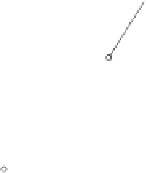Graphics Reference
In-Depth Information
Substituting Eq. (4.16) in Eq. (4.18) gives
·
=
+
·
n
p
d
n
n
Therefore,
·
−
·
−
n
p
d
n
p
d
=
=
(4.19)
·
2
n
n
n
But
q
=
p
−
2
n
Therefore,
2
n
n
·
−
p
d
=
−
q
p
(4.20)
2
n
which enables us calculate the location of Q.
If
n
is a unit vector
n
, then
ˆ
=
−
ˆ
·
−
ˆ
q
p
2
n
p
d
n
(4.21)
Let's explore two scenarios for these equations: one with a point behind the mirror and one in
front, which will demonstrate that mathematical mirrors possess two reflecting sides.
Y
1
Q
P
1
X
1
Z
Figure 4.16.
Figure 4.16 shows a triangular mirror whose plane equation is given by
x
+
y
+
z
=
1
where
n
=
i
+
j
+
k









